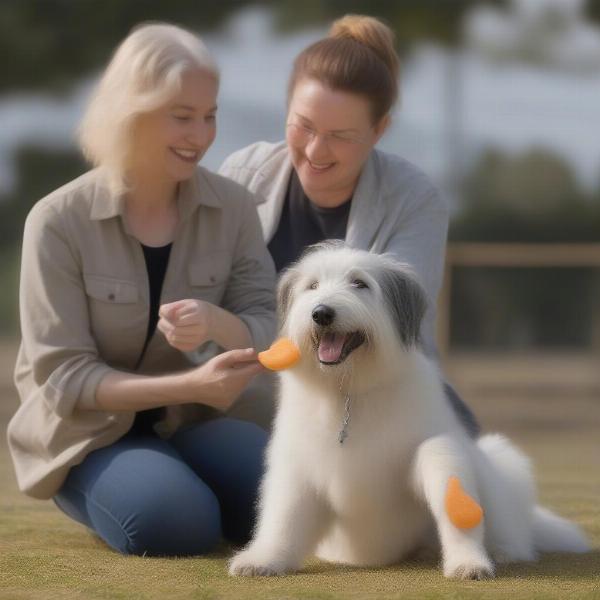Polish dogs encompass a fascinating variety of breeds, both native to Poland and popular within the country. Whether you’re interested in a robust working dog like the Polish Tatra Sheepdog or a charming companion like the Polish Lowland Sheepdog, understanding their unique characteristics is key to responsible ownership. This guide will delve into popular Polish dog breeds, exploring their history, temperament, care needs, and more.
Unveiling Poland’s Canine Heritage: Popular Breeds
Poland boasts a rich canine history, with several breeds originating within its borders. These dogs, often developed for specific tasks like herding or guarding, have unique traits that make them stand out. Let’s explore some of the most popular Polish dog breeds:
- Polish Tatra Sheepdog (Owczarek Podhalański): A majestic, large-breed dog traditionally used for guarding livestock. Known for their thick white coat, imposing size, and calm yet protective nature, they make loyal family guardians.
- Polish Lowland Sheepdog (Polski Owczarek Nizinny): A medium-sized herding dog with a distinctive shaggy coat. Intelligent and adaptable, they excel in various canine sports and make affectionate companions.
- Polish Greyhound (Chart Polski): A sleek and powerful sighthound bred for hunting. While elegant and reserved, they possess a strong prey drive and require experienced owners.
Temperament and Training: Nurturing a Well-Rounded Companion
Understanding your Polish dog’s temperament is crucial for successful training. While each breed has distinct personality traits, consistent and positive reinforcement methods are essential.
- Socialization: Early socialization is vital for all Polish dog breeds, exposing them to various people, animals, and environments to ensure they develop into well-adjusted adults.
- Training: Polish dogs are generally intelligent and eager to please, making them receptive to training. However, some breeds, like the Polish Greyhound, may require more experienced handling due to their independent nature.
 Training a Polish Dog
Training a Polish Dog
Health and Care: Ensuring a Long and Happy Life
Like all breeds, Polish dogs are susceptible to certain health conditions. Regular veterinary checkups, a balanced diet, and appropriate exercise are vital for their well-being.
- Grooming: Polish dogs, especially those with long coats, require regular grooming to prevent matting and skin issues.
- Exercise: Providing adequate exercise is crucial for both physical and mental health. The amount and type of exercise will vary depending on the breed.
Is a Polish Dog Right for You?
Choosing a dog is a significant decision. Consider your lifestyle, living situation, and experience level before welcoming a Polish dog into your home. Researching breeders thoroughly is crucial to ensure you’re getting a healthy and well-adjusted puppy.
Conclusion: Embracing the Polish Dog Spirit
Polish dogs offer a unique blend of loyalty, intelligence, and beauty. By understanding their specific needs and providing a loving and supportive environment, you can enjoy a rewarding partnership with these remarkable companions. Remember to thoroughly research breeders and prepare yourself for the responsibilities of dog ownership.
FAQ:
- Are Polish dogs good with children? Many Polish dogs can be good with children with proper socialization and training, especially breeds like the Polish Lowland Sheepdog. However, supervision is always necessary.
- What is the average lifespan of a Polish dog? The lifespan varies depending on the breed, but it typically ranges from 10 to 14 years.
- Are Polish dogs difficult to train? Polish dogs are generally intelligent and eager to please, making them receptive to training.
- Do Polish dogs require a lot of grooming? The grooming requirements depend on the breed. Long-coated breeds like the Polish Lowland Sheepdog require regular brushing.
- Are Polish dogs good apartment dogs? Some Polish dogs, like the Polish Lowland Sheepdog, can adapt to apartment living with sufficient exercise. However, larger breeds like the Polish Tatra Sheepdog are better suited to homes with yards.
- Where can I find a reputable Polish dog breeder? Researching breed-specific rescue organizations and contacting national kennel clubs are good starting points.
- What are the common health concerns in Polish dogs? Specific health concerns vary by breed, but some Polish dogs may be prone to hip dysplasia, bloat, and certain eye conditions.
Related Articles:
About ILM Dog
ILM Dog is your trusted resource for expert advice on dog breeds, health, training, nutrition, and more. We offer comprehensive guides and practical tips to help you provide the best possible care for your canine companion. Whether you’re looking to understand different breeds or need guidance on dog training techniques, ILM Dog offers valuable insights from experienced professionals. Contact us at [email protected] or +44 20-3965-8624 for personalized advice and support.